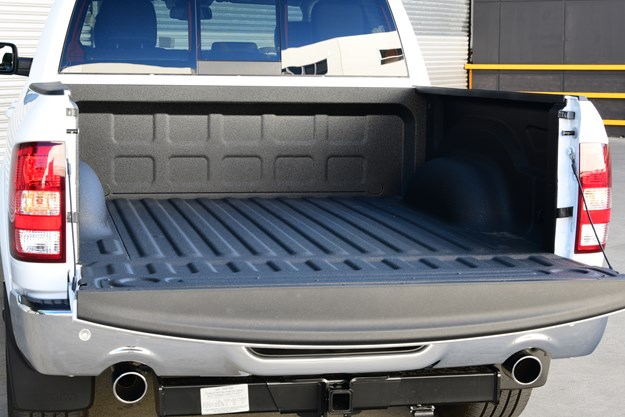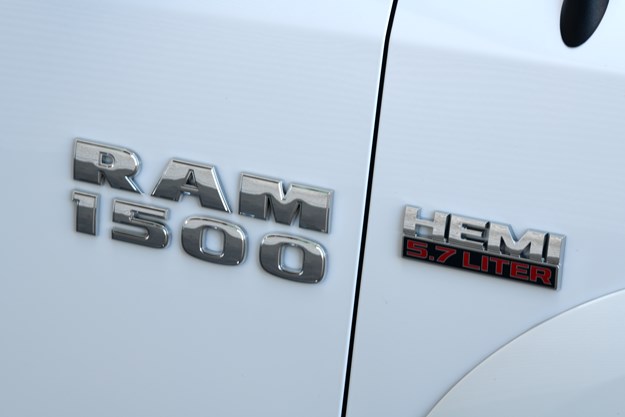The days of the petrol V8 ute have come and gone in Australia, something no rev head saw coming. Or have they …
There’s a new kid on the block with a winning combination; a 5.7-litre Hemi V8, 1,930mm tray, 800kg payload, 4.5-tonne towing capacity, and a raucous exhaust note.
It’s the Ram 1500 and it’s a potential game changer for the dual-cab-obsessed Australian market.
We drove the top-spec Ram 1500 Laramie both on and off-road at Bathurst in NSW, with an open mind and no real expectations having not spent much time in a big American ute.
 |
|
Off-road the RAM 1500 went where we needed it to, but was hindered by road tyres
|
While the Laramie we tested starts at $99,950 plus on-road costs, the $79,990 price point of the base model RAM 1500 sits at the upper end of the 4×4 dual-cab market, but you get a lot of vehicle for that money.
Compared to the popular 4×4 dual-cab ute options on offer in Australia, the first thing you notice is the size of the RAM.
It’s bigger, but up close you realise it isn’t that much wider than your typical dual-cab ute. At 5,817mm long and 2,017 wide, it’s longer but not much wider than other popular ute options.
 |
|
The impressive 1,930mm tray makes this ute tradie-ready, without sacrificing rear seat space
|
This additional length provides more overall tray and interior space than we’re used to in Australia, a welcome reality for ute buyers wanting wagon-sized rear seating with single-cab tray length.
In terms of styling the 20-inch chrome wheels are a bit loud and not typically something Australians go for, but this is an American ute and the chrome details are just part of that package.
The grunty V8 hurtled the 2,650kg ute forward with more enthusiasm than you get from the current spate of small-capacity turbo-diesel engines on offer in this segment, without us having to lean on the engine or rev it to the moon.
With 291kw of power and 556nm of torque, the V8 was significantly less thirsty than expected. RAM claims official fuel use of 9.9L/100kms thanks to cylinder de-activation and variable valve timing (VVT).
 |
|
The all-important HEMI badge, telling the world this beast is powered by a 5.7L V8
|
RAM mated the Hemi to an eight-speed auto with 4×4 as standard and for the driving we did, the gearbox made good use of the power on offer and held gears when pushed.
The big Hemi is happy to rev, but when unloaded this ute doesn’t ask too much of the engine, and in general urban driving it would frequently switch to ‘eco’ mode, which involves shutting down cylinders to run as either a V6 or V4.
In fact, the cylinder deactivation occurred so seamlessly the only real giveaway was a slight change in engine note, which instantly became that of a V8 when you dropped the boot.
The only thing we’d change about the engine is a slightly louder exhaust system at wide-open throttle – but for day-to-day use this system is quiet while still reminding you there are eight cylinders up front.
The multi-link coil spring rear was surprisingly compliant on the winding roads we drove, considering the weight of the vehicle, and when we hit a dirt road at 80km/h it was barely distinguishable in comparison with the bouncier leaf sprung rear ends most dual-cab utes offer.
We briefly took the RAM off road on a light track, which it handled on road-biased tyres, but we’d need more time and varied terrain to put this thing through its paces.
We also didn’t get a chance to put any weight in the back, but maxing out the RAM 1500’s 800kg payload would really put the rear coil setup through its paces and it’s something we plan on doing when we test the ute further.
The massive 4.5-tonne towing capacity is applicable for the 3.92 axle ratio, whereas a 3.21 ratio is offered with slightly better around-town economy in mind dropping the towing capacity to 3.5 tonne.
We also plan on tow testing this ute to see how it goes pulling the 4.5 tonne limit up back, but the torquey V8 and low axle ratio suggests it’d be a goer and for those with larger loads this is certainly a big drawcard.
 |
|
The 1500 Laramie we drove had an interior that felt more like something you’d find in an SUV than a 4×4 ute
|
A real gripe with dual-cab utes is back seats that aren’t exactly spacious, or comfortable. The RAM was refreshingly spacious up back, and we had men over six feet in height seated comfortably.
The interior is on par with modern SUV’s and while yes, we were in the top-of-the-line Laramie model, the quality inside the cab was top-notch.
The right-hand conversion, completed locally in Australia, is superb and from inside the cab it’s virtually impossible to tell this was once setup for the wrong side of the road.
This ute is one that’s larger, more powerful and also slightly more expensive than Australia’s most popular dual-cab ute options, but it’s also a one-of-a-kind offering in this market.
Australians love two things; utes and V8 engines – the RAM 1500 ticks both of those boxes.
SPECIFICATIONS:
2018 RAM 1500 LARAMIE
Engine: 5.7L Hemi 16-valve V-8
Power: 395hp (291kW) @ 5,600 rpm
Torque: 410lbft (556 Nm) @ 3,950 rpm
Transmission: Torqueflite eight-speed automatic
Front suspension: Upper and lower ‘A’ arms, coil springs, twin-tube shock absorbers, stabiliser bar
Rear suspension: Five-link with track bar, coil springs, stabiliser bar, twin-tube shock absorbers, solid axle
Steering: Electric power assisted
Length x width x height (mm): 5,817 x 2,017 x 1,917
Wheelbase (mm): 3,569
Towing, max. braked: 4,500 kg (70mm ball)
Tub payload: 800kg
Cargo tub SAE volume (cu m): 1.4
Gross vehicle mass: 3,450kg
Kerb weight: 2,650kg
Fuel consumption (combined): 12.2L/100km
Wheels: Alloy 20″
Tyres: Hankook Dynapro HT 275/60R20

